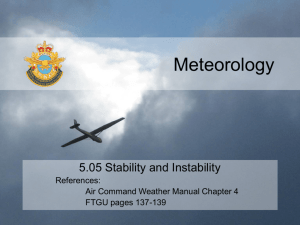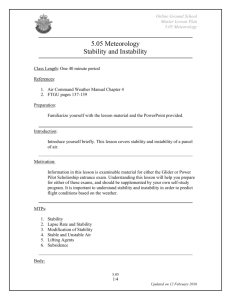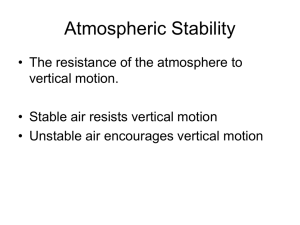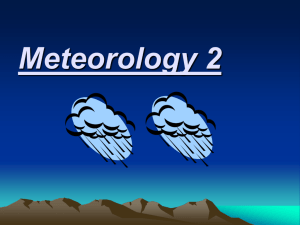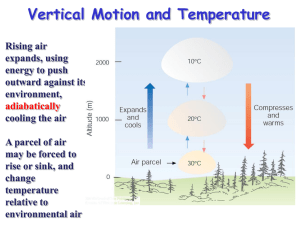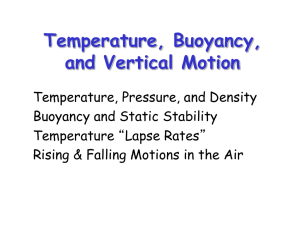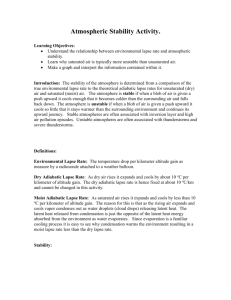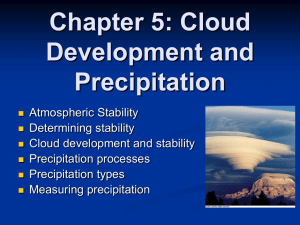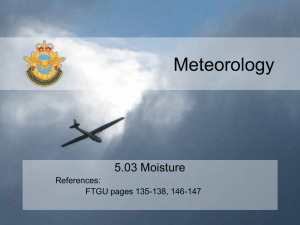5.05 Stability and Instability
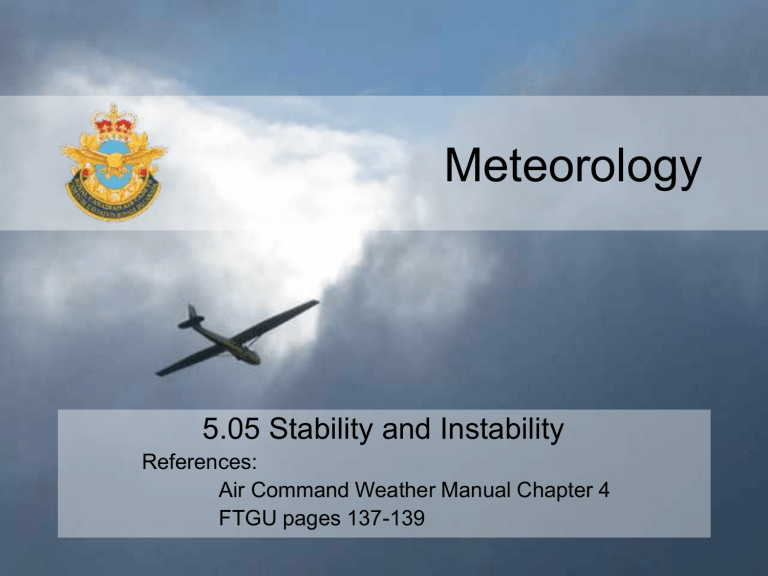
Meteorology
5.05 Stability and Instability
References:
Air Command Weather Manual Chapter 4
FTGU pages 137-139
Review
– 1. What does relative humidity mean?
– 2. Explain how clouds are formed.
– 3. Name three specific types of clouds and their abbreviations.
– 4. Name 4 types of precipitation.
– 5. Define lapse rate.
5.05 Stability and Instability
• MTPs:
– Stability
– Lapse Rate and Stability
– Modification of Stability
– Stable and Unstable Air
– Lifting Agents
– Subsidence
Stability
1- Positive 2. Negative 3. Neutral
Stability
Stability and Lapse Rate
• Unstable air indicated by steep lapse rate
• Steeper lapse rate = more unstable air
• Greater than the ICAO standard
• Stable air indicated by shallow lapse rate
• Shallower lapse rate = more stable air.
• Less than the ICAO standard
Modification of Stability
• Heating from below will cause instability
• Cooling from below will cause stability
Stable and Unstable Air
Characteristic
Lapse Rate
Cloud Type
Precipitation
Visibility
Wind
Turbulence
Stable Air
Shallow
Unstable Air
Steep
Stratus Type
Uniform Intensity including drizzle
Poor low level (Fog may occur)
Steady winds which can change with height
Generally smooth flying conditions
Cumulus Type
Showers
Good, except in precipitation
Gusty
Turbulence may be moderate to severe
Confirmation
Questions
• 1. What are the 3 types of stability?
• 2. What type of stability leads to smooth air?
• 3. A shallow lapse rate leads to what type of air?
• Convection
– Uneven heating of different types of surface
• Especially differences between areas of land and water
– Sun heats earth, heat radiates upwards rising currents of air separated by areas of sinking air
Lifting Agents
Sun Heats
The Earth
Rising Currents
Of Air
Lifting Agents
• Orographic Lift
– Air moving up a sloping terrain (ex. mountain) will continue its upward movement
– Unstable air will increase the amount of lift.
• Frontal Lift
• Warm Front
– Warm air advances on a retreating cold air mass
– Warm air ascends over the cold air in a long gentle slope
• Cold Front
– Mass of cold air advances on mass of warm air
– Undercuts the warm air, forces it to rise sharply
Lifting Agents
Lifting Agents
• Mechanical
Turbulence
– Also known as
“eddies”
– Friction between air and ground
– Irregular terrain and man-made obstacles cause severe eddies
– Usually confined to lower thousands of feet
Mechanical Turbulence
• Convergence
– Air flows from high to low pressure
– Air converges/meets over the centre of the low pressure
– Excess air is forced to rise.
Lifting Agents
Subsidence
• Occurs in High pressure systems or in air flowing down the side of a mountain
• As the air descends, it reaches regions of increased atmospheric pressure and is compressed
– As a result, its temperature rises.
Confirmation
• Name 3 lifting processes.
• What type of cloud is associated with:
– Stable air?
– Unstable air?
• Why does a steep lapse rate mean the air will be unstable?
• Good visibility is associated with what type of air?
Cloud to Cloud Lightning Strike
